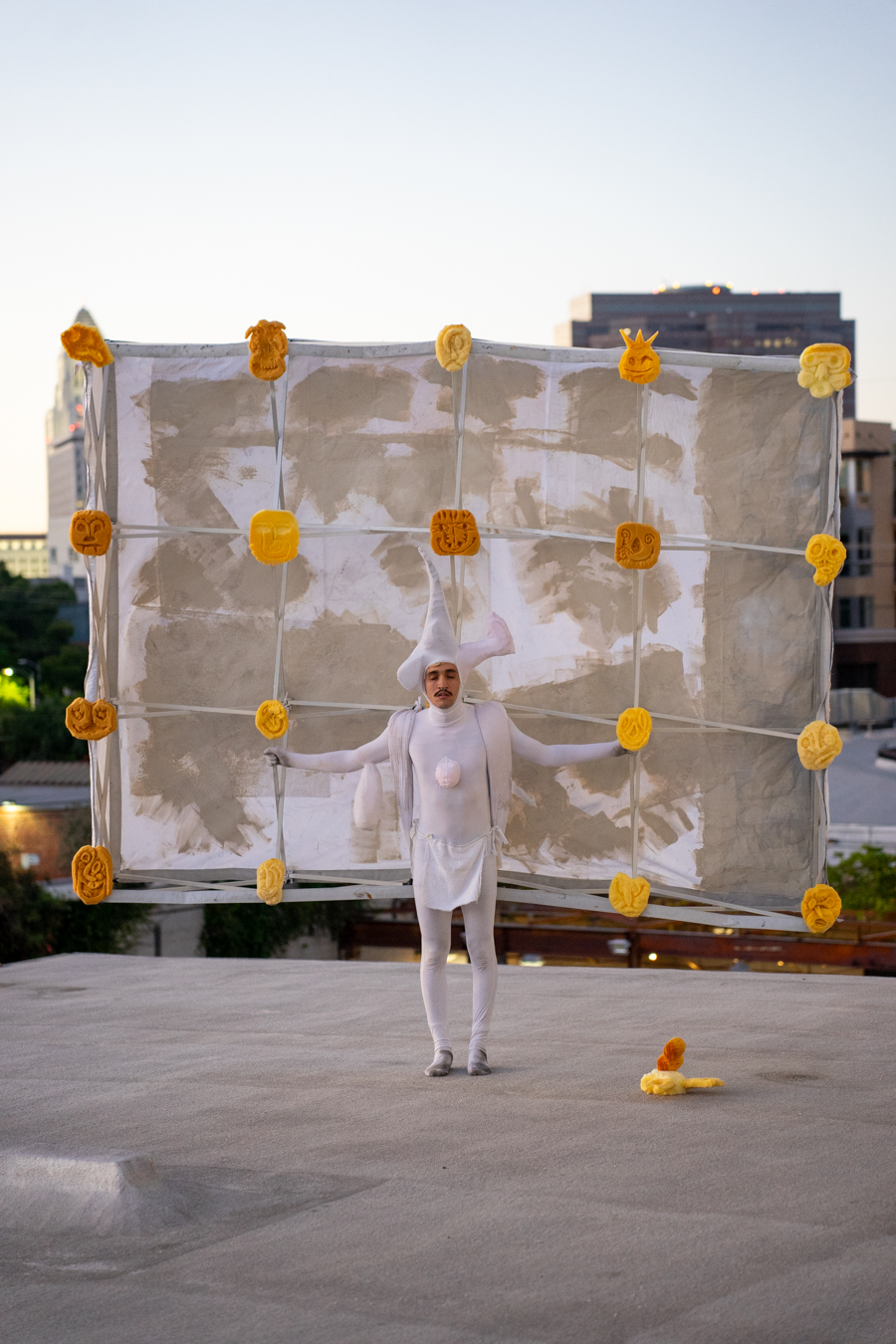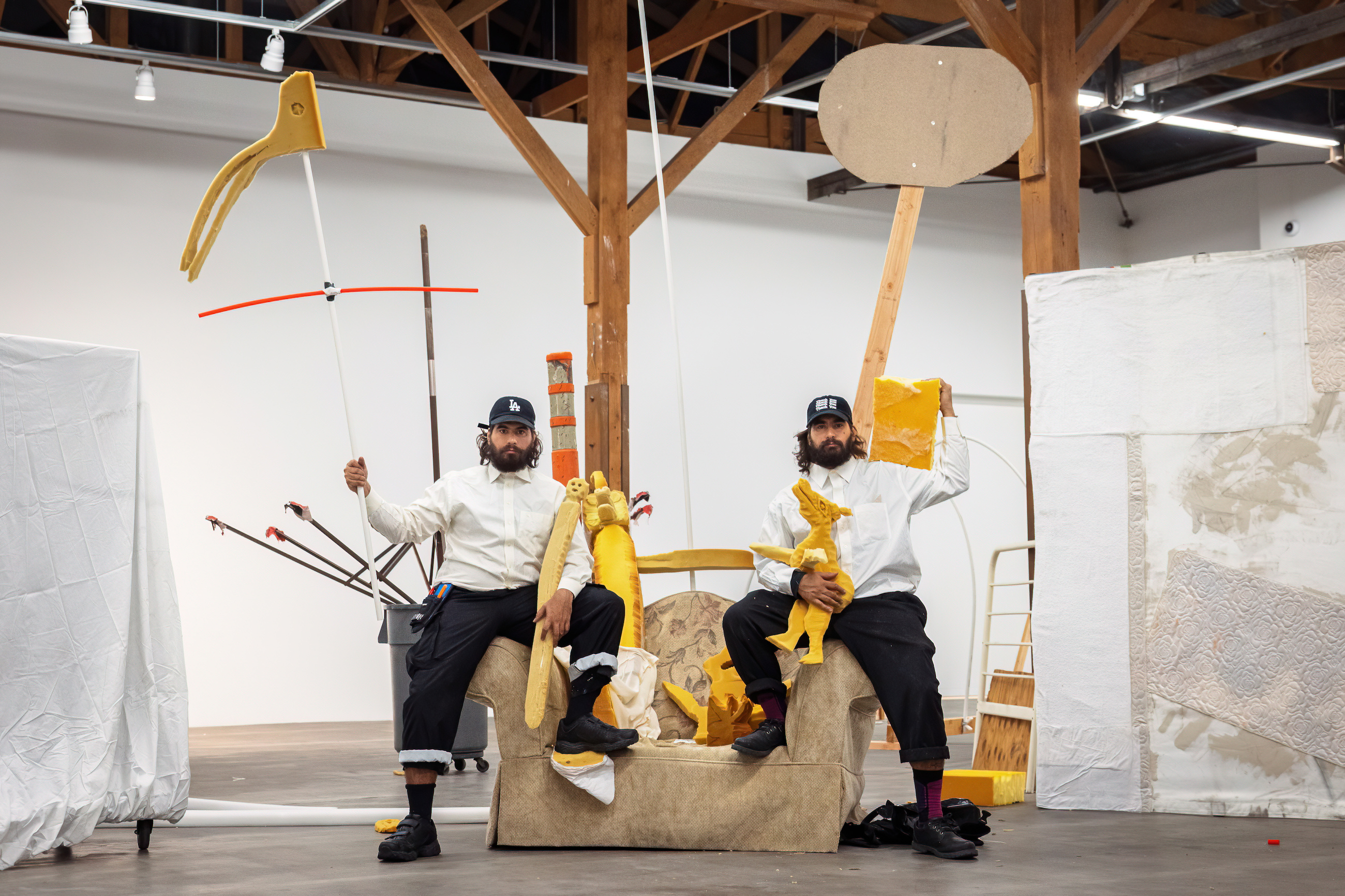Poncili Creación is in LA, preparing to take us by storm with the glory of trash at Hauser & Wirth Los Angeles. In advance of their November 11 performance, Our Name is Moving, I took part in their creative workshop POSSIBILITIES OF MATTER and sat with them for an interview to learn more about what they are doing here, and why.
The wild and crazy energy of Pablo and Efrain Del Hierro, identical Puerto Rican twins, sculptors and puppeteers, is a whirlwind of chaos and comedy. Silly, grotesque and wickedly smart, they whip through space bringing life to puppets of all shapes and sizes (though increasingly larger and larger) like a performative hurricane that sucks in and spits out the impossibilities of matter that has been left behind by society. Their fantastic puppets are fashioned from “the surplus, the amalgam, the bastard son of capitalism!”—commonly known as trash—birthing new realities and microdosing a little bit of hope for their audiences through the unexpected.
“We all came here today seeking something,” said Poncili Creación (PC) at the top of the workshop. They invited us on a four-hour creative journey to imagine and realize an improvement to a tool people had been using for hundreds of years. We would “soar over those obstacles society puts in front of us” by resourcing our materials from refuse as they do, materials that are “absolutely free:” like motel sheets in lieu of fabric; shoelaces and discarded appliance cables for string; shiny chopsticks as dowels; wood from abandoned construction sites; and above all, the almighty foam.
“We are literally obsessed with foam,” said PC, pointing out it is the same material that forms most every puppet we know from popular culture. It is their signature and preferred raw material with a host of benefits, including being easy to pack, containing an inherent dichotomy of soft rigidity, being “light as hell,” and offering functional comfort, to boot. They invited us to draw our idea on paper, and then envision it within a block of foam, insisting that whatever we sought to create was “already there.”
This was not a workshop to make a perfect puppet, they assured us—or even a workshop to make a puppet, to be perfectly clear (a massive relief, as I was there out of an abundance of enthusiasm, not artistic talent). The point of the workshop was not to make a final object, but to instill us with “the tools and belief that everything is possible through your hands by the mercy of trash.” If they did their job right, we’d all leave with the belief that we can make the impossible possible; that the world can change and that a new world can begin with us.
I did my best to push aside my own crippling self-doubts about my capacity to realize a metaphorical idea into the physical realm. I had decided to create a wearable hug. Simply completing the assignment was not sufficient—PC would not let me leave the workshop until my vision was adequately “finessed” to their liking. With knives and glue and a little help from my friends, PC, I fashioned a foam embrace one could wear as a constant hug that provides a steady sense of comfort on days that require it. In spite of myself, when I was finally permitted to leave, I felt a sense of quiet pride that I had pushed myself to explore my capacities to manifest something unique and transformative.

My wearable hug. Image courtesy Jay Ezra Nayssan.
A few days later over lunch, I got the inside scoop about Our Name is Moving, their upcoming special performance of an “audiovisual poem” at Hauser & Wirth Los Angeles. All credit for their residency was given to Jay Ezra Nayssan, the curator of “Nonmemory,” the gallery’s current exhibition that presents seminal works by the late Mike Kelley and a group of seven contemporary artists. Nayssan recognized the many similarities between PC and Mike Kelley’s oeuvre and invited PC to come on site to create work inspired by the artist.
They were up to task. They began researching Kelley’s work and found themselves particularly inspired by Kelley’s obsession with opposites, with “memory and nonmemory, architecture and nonarchitecture, oh, the past, but, oh, the future!” they cried in delight, working themselves up in a frenzy. “It’s a very short path from speculative biology to fantasy architecture,” they assured me. “All these puppets we’re imagining are a deconstructed version of humanity … nonverbal, nonlogical,” and not unlike an abstract painting or Kelley’s conceptual art.
Kelley’s attention to the atemporality of the present struck a particular chord with them. “Reality is just one moment,” they posited, jumping on each other’s words. “This has been the same moment forever—it’s always the present, it always has been—the old, old ancient present is still young.” They took this opportunity to invite their mother, an experimental dancer, to collaborate with them for the first time, bringing an “insane retro feedback time travel” quality to their upcoming performance. Like time folding onto itself, “We’re bringing her into what we do now, and having her do her old profession inside the framework of what her kids are doing, which relates to what she used to do.”
But most of all, PC felt inspired by Kelley’s use of movement in work like Mobile Homestead (2010). Harkening back to the urban origins of 15th-century puppetry, their work has been increasingly mobile in recent years, with the help of cars, cranes, wheels and feet, bringing joy to regular people on the streets, in schools, backyards, and basements—spaces “outside where traditional puppetry doth lie.” During the pandemic, they created Reality Breaker, a mobile puppet show built on a car. They transformed a major source of pollution on the planet into a vessel of entertainment for a family, an apartment building, or a whole street, without the danger of exchanging lethal germs. More recently, through the adornment of masks they alchemized a crane, the ultimate instrument of industrialization and gentrification, into a “fun-bringer and dream-maker!”

Photo: Natalia de la Rosa. Courtesy Poncili Creacion.
Their journey from buskers on the streets of Puerto Rico, entertaining the public through performance and with trash out of necessity, to featured artists at one of the world’s most lauded fine art galleries, is no small feat—though they have never doubted their own capacities to create their own reality. “We love doing shows for people who would never step foot into a theater … but then theater people started calling. And we started this game: how deep can we infiltrate, how many spaces with the same dumb puppet show? In a very serious way, how much can we land grab?”
They want more people to see their art and think, I can do that, “which is something most artists would never want people to say about their work. But that’s a sociopolitical act as well. It’s effective to create revolution on a personal level.”
Before I left our lunch, I thanked them for pushing me out of my comfort zone at the workshop, and not letting me quit on my wearable hug. “You made something so amazing!” PC said, with big smiles on their faces. “Honestly, it was just a good idea. Which means you’re going to have some more.”


